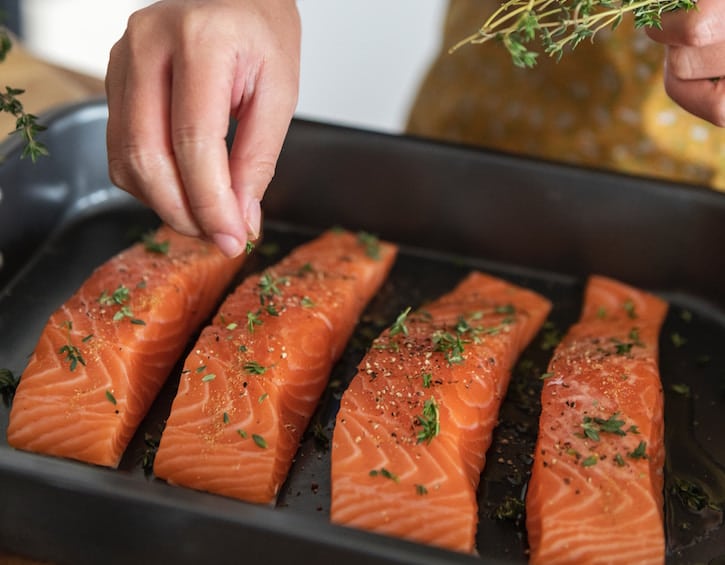





Family Doctor Cheryl Kam weighs in on the most crucial nutrients for kids, including how to get them into picky eaters (and what she gives her own son!)
Having a young toddler (and husband!) I understand how difficult it is getting them to eat all your lovingly prepared nutritious organic foods all the time, let alone take supplements. Moreover, the best supplement in the world is basically useless if your child simply doesn’t take it!
Click through the gallery to see the five key nutrients that we shouldn’t be missing out on in feeding our family (along with how to ensure your picky young eaters actually get them!).
Many mums start out low in Vitamin D, which we get for free from sunshine, and as a result pass very little vitamin D through breastmilk to their nursing babies.
This means many babies – especially breastfed babies – start out their lives with low vitamin D. We need vitamin D for bones, brains, and hormones! With low vitamin D, we end up absorbing less magnesium and calcium.
My strategy is to ensure mummy has had enough sunshine during the pregnancy or at least has vitamin D in her supplement regime, and to get naked babies out in the sunshine more often. This isn’t always possible, though, and babies therefore need D supplementation. All children between 6 months and 5 years need a minimum of 280 IU/day–340 IU/day.
Read more: Dr. Kam on the supplements SHE takes during pregnancy and beyond
DHA is most important for a growing brain from birth til around age 3. A mix of DHA and EPA is then needed for kids and adults aged 3 onwards.Omegas are found in wild caught salmon, pasture raised eggs, nuts and seeds.
Read more: Where to buy sustainable seafood in Singapore
Is your child getting enough omegas?
Here are the upper limits.
– Birth to 12 months: may take up to 500 mg/day omega3
– Kids 1 to 3: up to 700 mg/day omega3
– Kids 4 to 8: up to 900 mg/day omega3
– Kids 9 to 13: up to 1200 mg/day omega3
– Older teenagers, pregnant and breastfeeding mums may require as much as 1600 mg omega3 daily
As you can see, they are levels we would find in adult capsules. Therefore I skip all the formulations and simply break adult capsules into my child’s smoothie.
Two good brands to look out for are Nordic Naturals and Omegavia, who makes a pure product, and I would concentrate on giving the oil or breaking the capsules into a citrus smoothie. I would not bother with gummies, and would instead concentrate on increasing dietary sources if the above supplement plan fails the taste test.
This is found in any food that is orange in colour, such as sweet potato, papaya, carrots and pumpkins, and is crucial for skin and tissue growth, eyes and immunity.
Kids’ levels become low mainly because mother is also low and provided very little vitamin A in the breastmilk. Moreover, diets low in vitamin A can lead to persistent illness that affects absorption.
Cod liver oil is a wonderful supplement to take that contains the above 3 nutrients: Vitamin A, Omega 3 and Vitamin D. The taste may be the limiting factor, but if you start young, your child may not mind it.
If you live in 2018 and beyond, chances are your gut bacteria is that of “modern man” i.e. dysbiotic, from generations of industrial toxins, half a decade of drugs, hormone residues, pesticides and a “germ-phobic” and antibiotic-loving lifestyle.
This means that the balance of good and bad bacteria is totally off. Therefore, parasites, yeasts and unwanted bacteria easily colonise the gut and give inflammation, food intolerances and further chronic problems further down the line.
What can we do?
Ideally, I recommend homemade yoghurt and kefir, but especially in Asia most adults (and kids above 1 year old) aren’t good with cow’s milk products.
It is also as important to eat other fermented foods such as tempeh and sauerkraut and to eat enough fibre.
Especially for kids, they also form their microbiota by playing barefoot in the dirt daily!
In clinic, I use a prescription-only probiotic for kids and adults until the families get the hang of how to make homemade kefir, or establish their supply of small batch milk kefir.
While Vitamin C seems to have had all the limelight where immunity is concerned, zinc is actually the bigger problem in our society today. Many kids have zinc needs and, when low, can have low quality skin, hair, digestion, immunity and bones. Sometimes we can pick up zinc spots on the nails, and other signs.
Zinc + C is a powerful combo where immunity is concerned, and I give my son this, especially during travels.
I am a great fan of Immunped, which can be used from as young as 1 years old, has a delicious apple taste and a stable formulation of both vitamin C and Zinc. It’s also popular with our patients, especially when a child is entering a new school environment or is travelling.
Remember, nothing beats a nutritious diet but in a frank deficiency state it is better to work with an experienced doctor familiar with upper and lower limits, to boost the system and then plan a practical maintenance regime.
Want to learn more? Book a consult to discuss your family’s nutritional needs today!
Reference: https://www.ncbi.nlm.nih.gov/pmc/articles/PMC5537772
Lead image and papaya image sourced via Getty; Vitamin D image by Ignacio Campo; Omega 3 image by rawpixel; probiotics image by Drica Pinotti; Zinc image by Remi Yuan






 View All
View All




 View All
View All











 View All
View All







